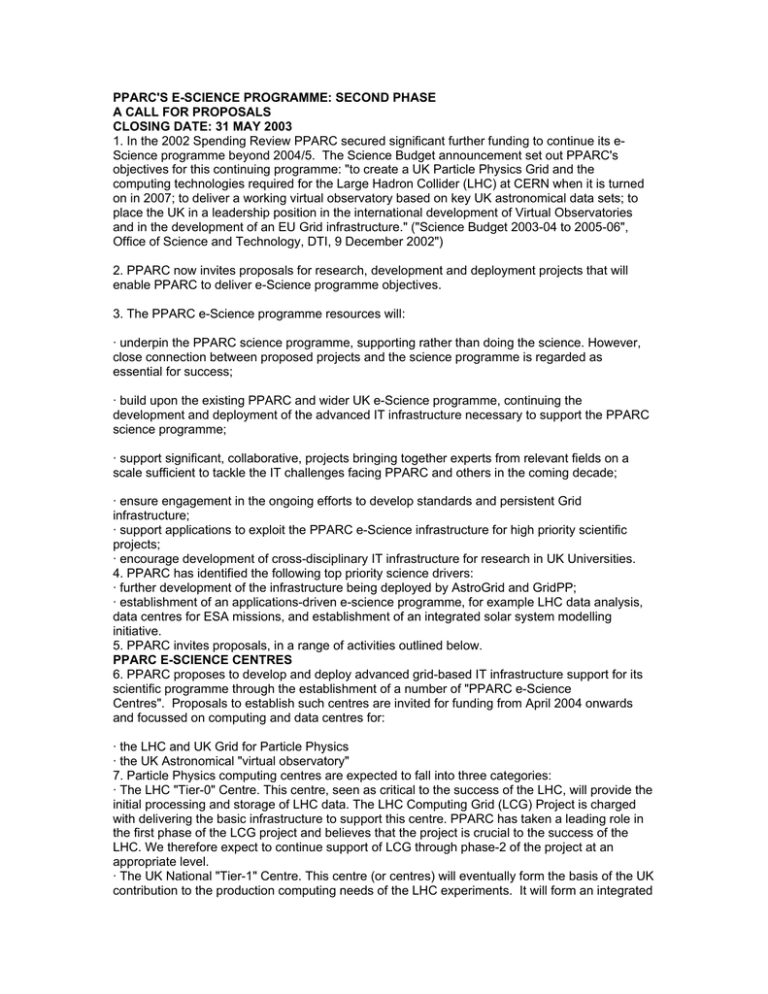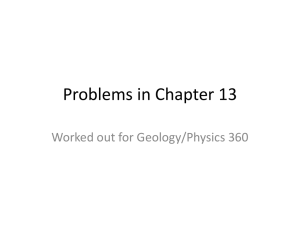PPARC'S E-SCIENCE PROGRAMME: SECOND PHASE A CALL FOR PROPOSALS
advertisement

PPARC'S E-SCIENCE PROGRAMME: SECOND PHASE A CALL FOR PROPOSALS CLOSING DATE: 31 MAY 2003 1. In the 2002 Spending Review PPARC secured significant further funding to continue its eScience programme beyond 2004/5. The Science Budget announcement set out PPARC's objectives for this continuing programme: "to create a UK Particle Physics Grid and the computing technologies required for the Large Hadron Collider (LHC) at CERN when it is turned on in 2007; to deliver a working virtual observatory based on key UK astronomical data sets; to place the UK in a leadership position in the international development of Virtual Observatories and in the development of an EU Grid infrastructure." ("Science Budget 2003-04 to 2005-06", Office of Science and Technology, DTI, 9 December 2002") 2. PPARC now invites proposals for research, development and deployment projects that will enable PPARC to deliver e-Science programme objectives. 3. The PPARC e-Science programme resources will: · underpin the PPARC science programme, supporting rather than doing the science. However, close connection between proposed projects and the science programme is regarded as essential for success; · build upon the existing PPARC and wider UK e-Science programme, continuing the development and deployment of the advanced IT infrastructure necessary to support the PPARC science programme; · support significant, collaborative, projects bringing together experts from relevant fields on a scale sufficient to tackle the IT challenges facing PPARC and others in the coming decade; · ensure engagement in the ongoing efforts to develop standards and persistent Grid infrastructure; · support applications to exploit the PPARC e-Science infrastructure for high priority scientific projects; · encourage development of cross-disciplinary IT infrastructure for research in UK Universities. 4. PPARC has identified the following top priority science drivers: · further development of the infrastructure being deployed by AstroGrid and GridPP; · establishment of an applications-driven e-science programme, for example LHC data analysis, data centres for ESA missions, and establishment of an integrated solar system modelling initiative. 5. PPARC invites proposals, in a range of activities outlined below. PPARC E-SCIENCE CENTRES 6. PPARC proposes to develop and deploy advanced grid-based IT infrastructure support for its scientific programme through the establishment of a number of "PPARC e-Science Centres". Proposals to establish such centres are invited for funding from April 2004 onwards and focussed on computing and data centres for: · the LHC and UK Grid for Particle Physics · the UK Astronomical "virtual observatory" 7. Particle Physics computing centres are expected to fall into three categories: · The LHC "Tier-0" Centre. This centre, seen as critical to the success of the LHC, will provide the initial processing and storage of LHC data. The LHC Computing Grid (LCG) Project is charged with delivering the basic infrastructure to support this centre. PPARC has taken a leading role in the first phase of the LCG project and believes that the project is crucial to the success of the LHC. We therefore expect to continue support of LCG through phase-2 of the project at an appropriate level. · The UK National "Tier-1" Centre. This centre (or centres) will eventually form the basis of the UK contribution to the production computing needs of the LHC experiments. It will form an integrated part of the world-wide LHC computing grid, providing data processing and storage services to the international LHC collaborations for the lifetime of the LHC. It will also act as a support centre for the UK Particle Physics Grid, linking smaller computing centres around the UK and providing a first point of call for user support to UK physicists. Proposals are invited for projects that will develop and deploy this UK centre over the period 2004-2007, in close collaboration with CERN and other partners. Proposals should demonstrate that the centre will take a leading role in LHC Computing Grid Project, support the computing needs of the LHC (and other) experiments before the start of LHC operations and be fully operational, integrating and supporting resources throughout the UK Grid, for LHC data in 2007. This centre would be expected to provide and support resources at a scale appropriate to the UK involvement in the LHC experimental programme and to do so for the duration of this programme. However, a truly integrated international computing system for the LHC implies that services may be made available to LHC collaborations via integrated European, or world-wide, programmes, on terms to be defined, rather than restricted to UK collaborators. · Local or Regional "Tier-2" centres. These will devote significant resources to LHC computing as a part of the integrated UK Particle Physics Grid and, by implication the wider LHC Computing Grid. PPARC invites proposals to establish such centres and expects to provide primarily the support staff resources. Proposals should show a significant hardware contribution from host institutions and build upon existing expertise in the grid computing required for LHC experiments. 8. Virtual observatory data centres are expected to support data from approved astronomical, solar and solar terrestrial physics missions or facilities. Building upon the development of the first UK virtual observatory (the AstroGrid), the Council wishes to see data centres for missions and facilities fully integrated into this infrastructure. Proposals are invited for the development and deployment of such data centres for existing facilities and approved ones such as VISTA and Gaia. Virtual observatory data centres will: · Take a leading role in the continuing development and support of virtual observatory infrastructure and provide the focus for maintaining and enhancing the UK's leading role in international virtual observatory developments. · Be fully integrated into the UK virtual observatory, making full use of software infrastructure developments funded by PPARC. · Provide access to the data held at the centre and appropriate processing support to users. · Build upon existing expertise and significant host institution investment in appropriate infrastructure. APPLICATIONS DEVELOPMENT 9. In addition to the above e-Science infrastructure, the PPARC is seeking to fund the development of applications to exploit the UK e-Science infrastructure in support of the approved PPARC science programme. Proposals should demonstrate that applications would be widely applicable, serving a wide user community and support PPARC's scientific programme as set out by the Science Committee (here: http://www.pparc.ac.uk/Rs/Cm/Plann/SCStrat.asp). In particular, proposals are invited for: · Development of the experiment specific software required to make most effective use of the UK Grid for Particle Physics and to ensure the UK's full readiness to exploit the LHC data. Projects should prepare the UK for full exploitation of the first LHC data in 2007, including software for simulation, reconstruction, analysis and collaborative working. Proposals may focus on providing software to support existing UK detector hardware commitments or to support a UK contribution to common projects. Proposals from experiment (UK) collaborations are encouraged. · Data processing pipelines for approved missions and facilities in Astronomy (e.g. VISTA and Gaia). Such developments should be fully integrated with the emerging UK Virtual Observatory (VO), building upon the VO developed tools and standards where appropriate. Collaborative developments with ESO or towards bids for hosting data centres for ESA missions are also appropriate. · Astronomical applications including data mining and analysis tools to ensure pervasive and effective use of the UK Virtual Observatory. Developments should be fully integrated with and build upon the current UK Virtual Observatory and e-Science programmes. · Initial software developments leading to the establishment of a solar system modelling initiative as part of PPARC's long-term Solar System science strategy. This should focus on the development of a flexible coupled model system that will enable researchers to build models of the energy flow through the Solar System tailored to their specific research needs. Collaborations bringing together appropriate expertise in physics, atmospheric sciences, modelling and computer science are invited to submit proposals to develop the principal spine, demonstrating that models can be coupled via it. This should cover issues such as coupling models of different spatial and temporal scales, coupling photo-chemistry and dynamics, data assimilation and visualisation. PROPOSALS 10. Proposals are welcome from consortia and individual UK institutions seeking to provide a coordinated solution to one or more of the above challenges. Centres developing a significant local collaboration between different sciences and/or industries are particularly welcome and may be eligible for joint funding through other Research Councils. Applicants must meet the normal eligibility requirements for grant funding. Further information can be found at section 2 of the PPARC grants handbook here: http://www.pparc.ac.uk/rs/rgh/rghData.asp?sb=2.2&si=n All PPARC e-Science projects will be expected to show commitment to and involvement in the relevant UK and International e-Science and Grid developments. Collaboration with UK Industry is strongly encouraged. 11. Proposals should: · Demonstrate direct support for the PPARC's prioritised science programme (http://www.pparc.ac.uk/Rs/Cm/Plann/SCStrat.asp). · Show commitment and strength in Grid computing and wider e-Science developments. This will include key roles in the UK e-Science programme, EU or other international projects, and evidence of national and international leadership in some areas, supported by significant local investment in relevant infrastructure and expertise. · Show how developments build upon PPARC's existing investment in e-Science and IT investment. · Provide support for a wide PPARC community. · Demonstrate close collaboration with other science and industry and with key international partners such as CERN, ESO, and relevant projects in the US and Asia. · Show medium to long term plans for development and support for the full duration of relevant PPARC science projects and a commitment to provide it. 12. Funding for projects will be available from April 2004. Where appropriate, longer-term commitments will be negotiated. 13. Proposals should contain details of full project costs, with detailed planning for the initial phases of the project. Where consortium proposals are submitted, details of project management and resource allocation procedures will be required. 14. All proposals will be fully reviewed by the PPRP and the PPARC Grid Steering Committee. Guidelines (http://www.pparc.ac.uk/Rs/Cm/Lettr/PPRP33_guidelines_for_major_projects.asp) for large are available proposals (total cost in excess of £1M) submitted to the PPRP and these guidelines should be used as the basis of such proposals. For smaller projects (less than £1M), proposals should be limited to a maximum of five pages. Further details will be sought as appropriate. The final programme recommended will be subject to approval by the Science Committee. 15. All proposals must be submitted electronically and reach PPARC by 31st May 2003. 16. Applicants are encouraged to discuss their proposals with PPARC in advance of submission. For further information please contact the PPARC e-Science Programme Manager Dr Guy Rickett (Guy.Rickett@pparc.ac.uk, tel: 01793 442014).


